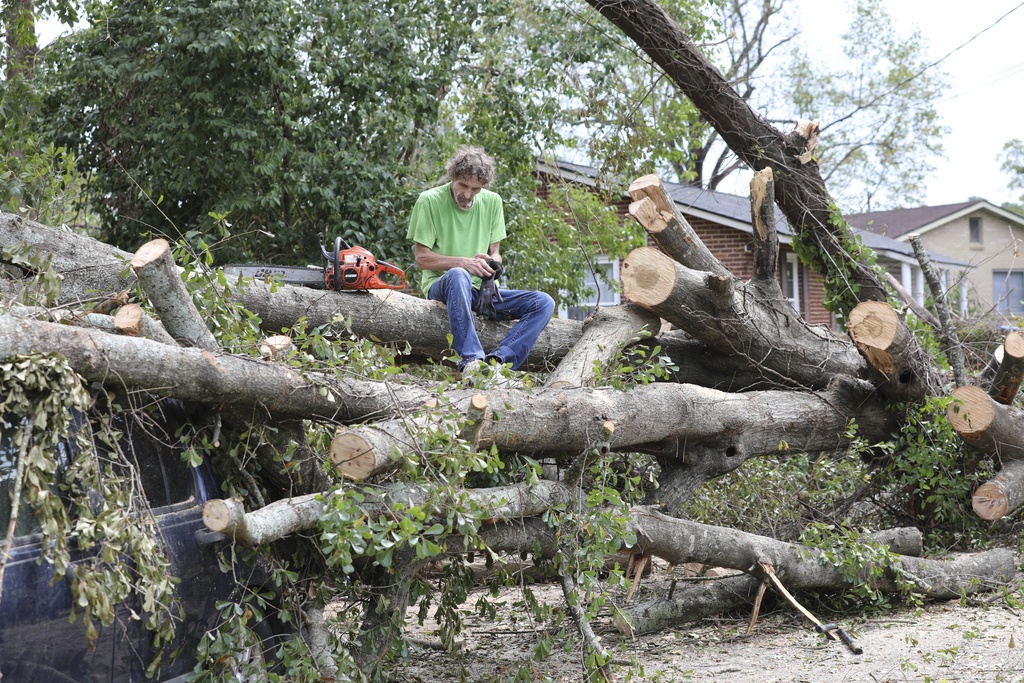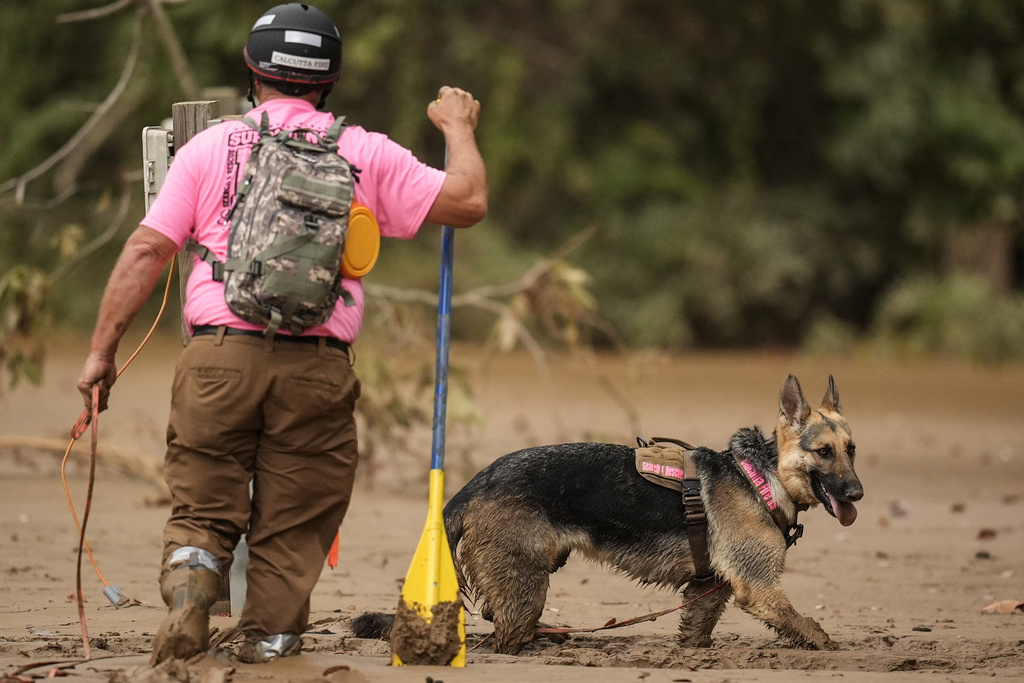Hurricane Helene Leaves 152 Dead Across Southeast \ Newslooks \ Washington DC \ Mary Sidiqi \ Evening Edition \ Hurricane Helene has left a devastating path across the Southeastern U.S., killing 152 people. Among the worst-hit areas are the Blue Ridge Mountains in North Carolina, where search teams continue to look for victims. Authorities are scrambling to restore power, clear roads, and provide aid as residents cope with massive disruptions.

Hurricane Helene Aftermath Quick Looks:
- Death Toll Climbs: South Carolina Governor Henry McMaster announced that Hurricane Helene has killed 152 people, with significant casualties across several states.
- Search and Recovery: Emergency crews in North Carolina, especially in Asheville and Swannanoa, are working to locate missing residents amid severe flood damage.
- Massive Power Outages: Nearly 150,000 households have registered for FEMA aid as power outages persist across affected areas.
- Federal Response: President Joe Biden plans to survey the destruction, while aid and rescue efforts continue with support from the Federal Emergency Management Agency (FEMA).
- Mobile Service Restored Slowly: Extensive damage to communication infrastructure hampers recovery, with efforts by Verizon and AT&T to restore phone service.
Deep Look:
Hurricane Helene has devastated much of the Southeastern United States, leaving a path of destruction that has now claimed 152 lives. South Carolina Governor Henry McMaster announced on Tuesday that 36 people had died in the state due to Helene, contributing to the storm’s grim overall death toll. The hurricane initially made landfall in Florida as a Category 4 storm last Thursday and proceeded to carve a deadly trail through Georgia, South Carolina, and North Carolina.
The remnants of Helene have brought immense challenges, especially in North Carolina, where cadaver dogs and search teams continued their grim work on Tuesday in the mountains of western North Carolina. They trudged through thick mud and heaps of debris, seeking missing people days after the storm unleashed torrential rains and destructive winds across the region. With bridges washed out and roads blocked, searchers used helicopters to access remote areas, often hiking through rough wilderness to check on isolated homes.
As of now, North Carolina has borne the brunt of Helene’s fury, with nearly half of the fatalities occurring there. The devastation was particularly severe in the Blue Ridge Mountains, including the area around Asheville, a region known for its art scene and outdoor tourism. More than 50 people have died in and around Asheville alone. In nearby Swannanoa, receding floodwaters revealed scenes of utter destruction—cars piled on top of each other, trailer homes dislodged and washed away, and streets covered with mud and sinkholes. Exhausted emergency responders worked relentlessly to clear blocked roads, restore power, and deliver aid to those still stranded.
Roy Cooper, the Governor of North Carolina, spoke somberly about the hurricane’s impact on the region, declaring, “Communities were wiped off the map.” The recovery efforts have been formidable, with over 150,000 households already registering for aid with the Federal Emergency Management Agency (FEMA). Frank Matranga, a FEMA representative, stated that this number is expected to grow significantly as the full extent of the damage becomes clear. Nearly two million ready-to-eat meals and more than a million liters of water have been sent to the hardest-hit areas to help those struggling with basic necessities.
Among the many tragic stories of those lost to Helene, there are numerous accounts of people being swept away by floodwaters or killed by falling trees. One particularly heartbreaking incident involved a couple and their young son, who perished when part of their home collapsed as they were waiting on their roof for rescue. Search teams in and around Asheville began by checking on the most vulnerable residents, attempting to account for everyone who may have been left behind. “We’ve been going door to door, making sure that we can put eyes on people and see if they’re safe,” said Avril Pinder, county manager for Buncombe County, which encompasses Asheville. Pinder added that there are still places that remain difficult to access.
In the aftermath of the storm, the floods in North Carolina have been described as some of the worst in a century. Over two feet of rain inundated parts of the state, with significant damage to several main highways. Interstate 40, a major route, was closed in places due to a massive mudslide. Though a section of the highway reopened on Tuesday, another stretch near the North Carolina-Tennessee border remains impassable. Joey Hopkins, the Secretary of Transportation for North Carolina, urged residents to stay off the roads to allow emergency crews to do their work safely.
In Asheville, many residents were still without power on Tuesday, making the search for basic necessities a challenge. Elizabeth Teall-Fleming, who had lost electricity, was waiting in line at a grocery store hoping to find nonperishable food items. She planned to cook over a camp stove at home, grateful just to have access to supplies. “I’m just glad that they’re open and that they’re able to let us in,” she said, adding that she was shocked by the extent of the storm’s damage.
Hurricane Helene came ashore in Florida late last week, making a strong landfall as a Category 4 storm before moving north, leaving devastation across the Southeast. In Georgia, the storm disrupted life across several major cities, including Valdosta and Augusta, where residents queued for water at distribution points set up in response to widespread power outages. “It’s been rough,” said Kristie Nelson from Augusta, who had no clear timeline for when her electricity would return. “I’m just dying for a hot shower,” she lamented.
Meanwhile, in Tennessee, Governor Bill Lee traveled to the eastern part of the state on Tuesday to assess the damage left by Helene. In some places, like a high school that had been destroyed by the storm, local residents told Governor Lee that his was the first official visit they had seen since the hurricane had passed. Frustration was palpable among some residents, one of whom voiced their despair, saying, “Where has everyone been? We have been here alone.”
South Carolina was also heavily affected, with at least 36 deaths reported—making Helene the deadliest tropical cyclone to strike the state since Hurricane Hugo, which killed 35 people in 1989. Roads were blocked, homes were lost, and entire communities had to be evacuated as the storm battered the region.
The widespread destruction brought on by Hurricane Helene also left significant damage to communications infrastructure, causing prolonged outages for internet and cellular services across multiple states. The Federal Communications Commission reported that the challenges of restoring communications were exacerbated by the remote and mountainous terrain of areas like western North Carolina. Verizon and AT&T deployed teams to restore cell towers, repair fiber cables, and provide temporary connectivity solutions. David Zumwalt, president and CEO of the Association for Broadband Without Boundaries, emphasized the difficulties of reaching sparsely populated, heavily damaged regions to restore crucial communication services.
One of the reasons western North Carolina suffered particularly extensive damage is that the remnants of Helene collided with the higher elevations and cooler air of the Appalachian Mountains, intensifying rainfall even further. Many towns in the region, including Asheville, are situated in valleys, making them vulnerable to flash floods when heavy rains fall. The ground had already been saturated from prior rains, leaving no capacity to absorb the deluge brought on by Helene. Christiaan Patterson, a meteorologist with the National Weather Service, highlighted how climate change has exacerbated these situations, leading to conditions that allow storms to intensify rapidly over warming waters before making landfall.
Helene’s effects were also devastating throughout Georgia, where communities were overwhelmed as the storm moved inland. The widespread power outages and infrastructure collapse affected residents from Valdosta to Augusta. Lines of cars were seen waiting for supplies like water, underscoring how desperate conditions had become.
As the cleanup continues, officials are already eyeing the Atlantic, where Tropical Storm Kirk is rapidly gaining strength. The U.S. National Hurricane Center reported on Tuesday that Kirk is expected to become a hurricane by late Tuesday night, and it could potentially become a major hurricane by Thursday. The storm, located roughly 1,010 miles west of the Cabo Verde Islands, currently poses no threat to land, but its development serves as a stark reminder of how active this hurricane season has been.
As President Joe Biden prepares to visit the affected areas on Wednesday, the focus remains on relief and recovery. However, many challenges lie ahead for those impacted by Hurricane Helene, with the daunting tasks of rebuilding communities and restoring essential services still in their early stages.
Hurricane Helene Leaves 152 Hurricane Helene Leaves 152 Hurricane Helene Leaves 152







